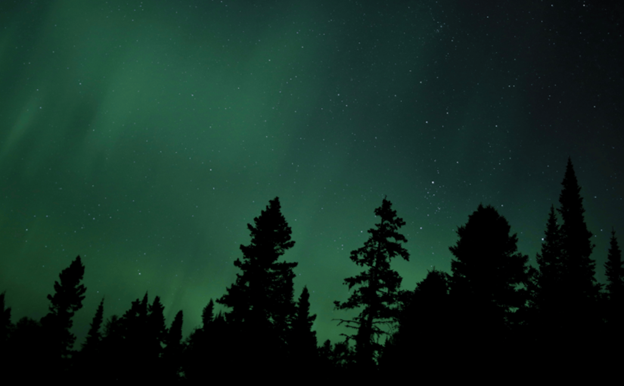We all crave the peace and quiet of a moment in the darkness, gazing up at the beauty of the night sky. But sometimes it’s hard to make out things in the pure darkness of provincial parks.
Did you know you can actually improve your ability to see in the dark? Most people do not realize there are a number of techniques you can use to improve your night vision. In this article we will explain four things you can do to see better in the dark.
We hope it will allow you to not only see more objects in the night sky, but to safely navigate your campsite at nighttime.
Understanding the eye
Before we get into any of our specific techniques, let’s talk a little bit about the eye.
The eye is one of the most amazing structures found in the animal kingdom. It is often considered an extension of the brain itself. So, the next time you look into someone’s eyes, you are actually looking at their brain!

The white of the eye provides protection and support for the retina, which is at the back of the eye. The most visible part of the eye is the iris, the green part in the diagram above. The pupil is the part of the eye light travels through, represented by the black circles in the diagrams.
Our eyes have evolved to provide us with the ability to see reasonably well in both daylight and at nighttime. In bright sunshine, our pupil contracts to a very small opening to protect our visual receptors from too much light. At nighttime, our pupil dilates to let in as much as possible.
Light travels through the pupil of the eye, and is focused on the back end of the retina. The retina is made up of billions of photoreceptor cells, which help us see colour, sharpness, and dim objects. When light strikes a photoreceptor, a chemical reaction occurs, which is translated to an electrical signal sent to the brain.
Two uniquely different cells are involved in seeing. The “cones” allow us to see colour and sharpness, and are concentrated in the centre of our vision. They are sensitive to colour, but not too sensitive to faint objects. The “rods” allow us to see faint objects, but are relatively insensitive to colour. The rods are more concentrated in a ring around our central vision.

When seeing faint objects, we need to rely upon our rod photoreceptors more than our cones. As a result, we must do whatever we can to improve the rod’s sensitivity to light.
How the eye adapts to darkness

In the dark, our eyes go through a process of replenishing their photoreceptor chemicals, which are constantly in use when seeing. The process of replenishing our photoreceptor chemicals is known as dark adaptation, and takes about 20 to 30 minutes on average.
That’s why you find your way easily to the fridge for a midnight snack, but, should you turn on a bright light, find it harder to find your way back.
The four techniques that can be easily used to improve your night vision are:
- Protecting your eyes from extreme conditions
- Keeping one eye shut before observing
- Using a red filter
- Using averted vision
Protecting your eyes from extreme conditions

The first tip should seem obvious now, and that is to keep out as much light as possible before it gets dark.
The more chemicals used by the photoreceptors to respond to bright conditions, the longer it may take to dark adapt. Evidence suggests that, if one has been exposed to very bright conditions it could take hours to dark adapt. This includes bright sun against either a snowy background, or a bright sandy beach. Caution should be taken by wearing sunglasses during the day to protect the quality of night vision at night.
Keeping one eye shut before observing

The second tip is to keep one eye shut before being exposed to bright light. Say, for example, that you need to grab something in your backpack at night, and you have to turn on a flashlight to find it. Keep one eye fully shut, and use the other for finding that item in the backpack with the flashlight on.
Now, after you turn off the flashlight, open the closed eye, and close the open one. You will be able to see much better in the dark with the previously closed eye that was not exposed to light. Until it becomes dark adapted, you will not be able to see much with the eye that was exposed to the flashlight. This may seem remarkably silly, but we promise it works very well!
Using a red filter

Is there a way we can use our knowledge of rod and cone receptors to protect our night vision? Actually, the answer is yes!
Because we use only our rods for night vision, there is indeed a trick we can use. This is to use a colour of light that the rods are practically insensitive to, and the cones see well – red light. As it turns out, using only red light at night is an extremely effective way to preserve your night vision. Either cover your flashlight with a red filter, or use red goggles in places where you can’t.
Using averted vision

The last of our tips is to maximize the use of our rods by knowing how to look at something that is faint. Let’s take a look at our cones and rods again.

You can see that while the cones are concentrated towards your central vision, the rods are not. They are concentrated in a ring that is about 20 degrees off from central vision. So, to maximize your rods, you can aim your gaze such that the object you want to see is off centre by about 20 degrees.

An example is seeing the Andromeda Galaxy. If one goes to the dark skies of our provincial parks, you may see the Andromeda Galaxy in the constellation of Andromeda. However, trying to see this faint smear of light by staring straight at it is somewhat challenging.
On the other hand, if you direct your gaze away so that you look at a star 20 degrees off from centre, the galaxy will “pop” into view within your peripheral vision. This amazing trick is known as using averted vision.
We hope that by using a combination of these four techniques, your camping and nighttime viewing pleasure will be greatly increased!



